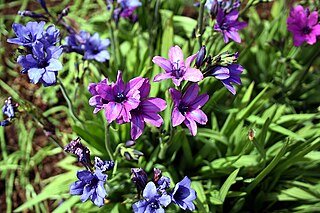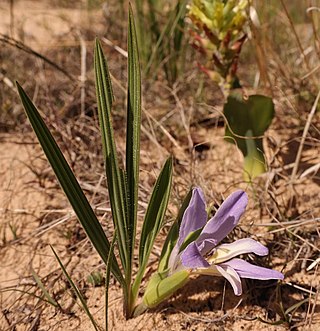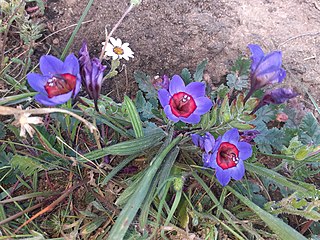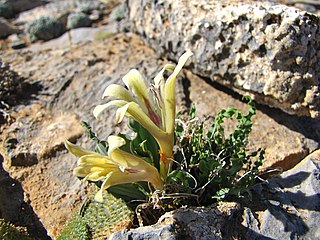
Freesia is a genus of herbaceous perennial flowering plants in the family Iridaceae, first described as a genus in 1866 by Christian Friedrich Ecklon (1886) and named after the German botanist and medical practitioner, Friedrich Freese (1795-1876). It is native to the eastern side of southern Africa, from Kenya south to South Africa, most species being found in Cape Provinces. Species of the former genus Anomatheca are now included in Freesia. The plants commonly known as "freesias", with fragrant funnel-shaped flowers, are cultivated hybrids of a number of Freesia species. Some other species are also grown as ornamental plants.

Iridaceae is a family of plants in order Asparagales, taking its name from the irises. It has a nearly global distribution, with 69 accepted genera with a total of c. 2500 species. It includes a number of economically important cultivated plants, such as species of Freesia, Gladiolus, and Crocus, as well as the crop saffron.

Gladiolus is a genus of perennial cormous flowering plants in the iris family (Iridaceae).

Babiana ringens, the rat's tail, is a flowering plant endemic to Cape Province of South Africa. The foliage is long and erect with an inflorescence consisting of a sterile main stalk adapted for ornithophily, pollination by birds. The plant bears bright red, tubular flowers on side branches close to the ground. It is a perennial that grows in nutrient-poor sandy soil and flowers during the winter rains.

Babiana is a genus of geophytes in the family Iridaceae with 93 recognized species as of March 2022. The leaves consist of a stalk and a blade that are at an angle to each other. The leaf blades are entire, laterally flattened and pleated, and often hairy. Each individual flower is subtended by two hairy or smooth bracts that are green in most species. The outer bract is often the largest of the two. In most species the bracts have a dry, brown tip, but in a few species it is entirely green or entirely dry when flowering or the outer bract is translucent and has a papery texture. The inner bract is forked or split all the way to its base. Each flower is without a pedicel, with six tepals that are merged at their base into a tube and form a perianth that is mirror-symmetrical in most species, with three anthers implanted where the perianth tube widens and that are, in almost every species, clustered at one side of the style. The style has three branches that widen towards the tip and the ovary is inferior. Flowers occur in almost every conceivable colour, many have markings on some of the tepals, and few star-symmetrical flowers have a centre that strongly contrasts with the free part of the perianth. The majority of these species are endemic to the west and southwest of South Africa, and southwestern Namibia, but one species occurs elsewhere in Namibia and South Africa and another species can be found in Botswana, Namibia, South Africa, Zambia and Zimbabwe. The genus name is derived from the Dutch word baviaan, referring to the Chacma baboon, Papio ursinus, that consumes the corms of plants in the genus. The genus is called bobbejaantjie in Afrikaans, meaning small baboon.

Babiana stricta, the baboon flower or blue freesia, is a species of flowering plant in the family Iridaceae, native to Cape Province, South Africa and naturalized in Australia.

Babiana ambigua is a species of plant in the Iridaceae. It is endemic to the Western Cape province of South Africa. It is a geophyte, that appears from an underground corm every year and grows to a height of 5–8 cm (2.0–3.1 in) or occasionally up to 16 cm (6.3 in). Its leaves are pleated, hairy, lance-shaped, reaching higher than the inflorescence. The fragrant, mirror-symmetric, blue to mauve flowers, consist of six tepals merged into a tube at their base, but with free lobes at the top. The lower lateral tepals have whitish markings accentuated by a more intense blue line along their margin. Each flower is supported by two green bracts sometimes with a brownish tip, and the inner bract is divided entirely to its base. There are three anthers crowded to the dorsal side of the perianth and a style divided in three branches on top of a smooth ovary. Flowers can be found from late July at sea level to the end of September at high altitude.

Babiana nana is a species of geophyte of 6–15 cm (2.4–5.9 in) high that is assigned to the family Iridaceae. It has leaves that consist of a sheath and a blade that are at an angle with each other. The leaf blades are oval to almost line-shaped and have a left and right surface, rather than an upper and lower surface. The leaf blades are moderately pleated and covered in dense, soft hairs. The inflorescence contains two to six blue to violet or pale pink flowers adorned with white markings on the lower lip, and with three stamens crowding under the upper lip. Flowering occurs from late August to the end of September. The flowers emit a smell reminiscent of roses or violets.
Peter Goldblatt is a South African botanist, working principally in the United States.

Babiana vanzijliae is a species of geophyte of 4–12 cm (1.6–4.7 in) high that is assigned to the family Iridaceae. It has leaves that consist of a sheath and a blade that are at an angle with each other. The leaf blades are narrow, sword- to lance-shaped and have a left and right surface, rather than an upper and lower surface. The leaf blades are pleated and covered in velvety hairs. The inflorescence contains three to five pale bluish mauve to yellow flowers, but the lower lateral tepals are yellow becoming pale around the edges, and with three stamens crowding under the upper lip. Flowering occurs from early August to the middle of September. The flowers emit a strong scent. B. vanzijliae grows along the Bokkeveld Escarpment near Nieuwoudtville in the Northern Cape province of South Africa.

Babiana lobata is a species of geophyte of 12–25 cm (4.7–9.8 in) high that is assigned to the family Iridaceae. It has leaves that consist of a sheath and a blade that are at a slight angle with each other. The leaf blades are narrow, sword- to lance-shaped and have a left and right surface, rather than an upper and lower surface. The leaf blades are slightly pleated and hairless. The inflorescence contains seven to twelve bluish mauve mirror-symmetrical flowers comprising six tepals, with the lower lateral tepals yellow sometimes flushed mauve at their tips, and with three stamens crowding under the dorsal tepal. Flowering occurs in July and August. The flowers emit a faint acrid-metallic scent. B. lobata grows in part of the Richtersveld in the Northern Cape province of South Africa.

Babiana villosa is a species of geophyte of 10–20 cm (3.9–7.9 in) high that is assigned to the family Iridaceae. It has mauve-pink, purple or scarlet star-symmetrical wide chalice-shaped flowers with narrow tube, large, blackish or dark purple anthers, and velvety hairy, lance-shaped, laterally compressed leaves, set in a fan. Flowers occur during August and September. It grows between Malmesbury and Wellington in the Western Cape province of South Africa. It is commonly called red babiana in English and rooibobbejaantjie in Afrikaans.

Babiana hirsuta is a species of geophyte of 40–70 cm (16–28 in) high that is assigned to the family Iridaceae. It has many scarlet mirror-symmetrical flowers in a branched inflorescence with several short ascending branches. The flower has a narrow tube, and three large, blackish or dark purple anthers that extend beyond the dorsal tepal. The leaves are velvety hairy, lance-shaped, laterally compressed and set in a fan. It is an endemic species of South Africa that can be found along the west coast of the Northern and Western Cape provinces as far south as Saldanha. It is called red babiana in English, but that name is also applied to Babiana villosa, and strandlelie, sandlelie and rooihanekam in Afrikaans. Until 2008, the strandlelie was known as Babiana thunbergii.

Babiana tubiflora is a species of geophyte of 7–15 cm (2.8–5.9 in) high that is assigned to the family Iridaceae. It has whitish mirror-symmetrical flowers with a long narrow tube that split into six tepal lobes, have three stamens, and line- to lance-shaped, laterally compressed leaves. It is an endemic species of South Africa that can be found along the west and south coast of the Western Cape province. It flowers from August to early October.

Babiana sambucina is a species of geophyte of 8–30 cm (3.1–11.8 in) high that is assigned to the family Iridaceae. It has dense spikes of blue to violet-coloured, often fragrant flowers. There are two subspecies, B. sambucina subsp. longibracteata is restricted to a small area in the Northern Cape, B. sambucina subsp. sambucina grows in the Western Cape and Eastern Cape provinces of South Africa. Flowers are present in August and September.

Babiana rubrocyanea is a perennial geophyte of 5–15 cm (2.0–5.9 in) high, with entire, lance-shaped, hairy, pleated leaves and flowers that have a narrowly funnel-shaped tube at their base and six free tepal lobes at the top that form a wide cup that is purplish blue with a sharply defined carmine red centre. It can be found in a small area of the Western Cape province of South Africa. Flowers can be found from August to the middle of September. It is called blue-and-red babiana in English and rooibloubobbejaantjie in Afrikaans.

Babiana scabrifolia is a perennial plant of 5–15 cm (2.0–5.9 in) high that annually forms leaves and flowers from an underground corm and is assigned to the Iris family. It produces relatively large, pale lilac or blue flowers slightly above the soil, and soft, lightly pleated leaves that reach beyond the flowers. These leaves are lance-shaped to oblong in adults, but line-shaped and twisted in non-flowering specimens. Flowering occurs from June to August. The species can be found in the Western Cape province of South Africa.

Babiana cinnamomea is a perennial plant of about 4–6 cm (1.6–2.4 in) high that annually forms leaves and flowers from an underground corm that is assigned to the iris family. It has inconspicuous pale greenish yellow flowers and broad, hairless, pleated leaves with undulating margins. Flowers may be found in May and June. It occurs in the very north of the Western Cape province of South Africa.

Babiana hypogaea is a perennial plant of about 5–8 cm (2.0–3.1 in) high that annually forms leaves and flowers from an underground corm that is assigned to the iris family. It has pale greenish yellow, buff or rarely white, mirro-symmetrical flowers and line- to sickle-shaped, slightly pleated, thinly hairy or hairless leaves that are held horizontally or inclined, that grows in the summer rainfall areas of southeastern Namibia and central and northern central South Africa. Flowers may be found between June and September and sometimes between December and May. It is called Bobbejaankalkoentjie, Bobbejaanuintjie or Ertappeluintjie in Afrikaans.

Babiana mucronata is a perennial plant species that grows to about 5–18 cm (2.0–7.1 in) high and annually forms leaves and flowers from an underground corm. It is assigned to the iris family. It has a simple or branched, more or less upright spike of 3-12 dark to pale violet-blue, mirror-symmetrical flowers. Each flower consists of a perianth that is merged below into a funnel-shaped tube of 10–25 mm (0.39–0.98 in) long but splits into six unequal tepals. Three stamens are curved, crowded near the upper lip, and carry pale violet anthers. Flowers may be found between late July and September.


















